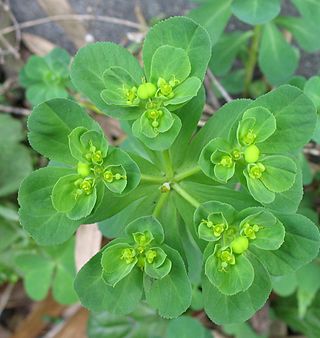Milkweed , Asclepias, is a genus of herbaceous, perennial, flowering plants named for their milky latex sap.
Contents
Milkweed may also refer to:
Milkweed , Asclepias, is a genus of herbaceous, perennial, flowering plants named for their milky latex sap.
Milkweed may also refer to:

Euphorbia is a very large and diverse genus of flowering plants, commonly called spurge, in the family Euphorbiaceae. "Euphorbia" is sometimes used in ordinary English to collectively refer to all members of Euphorbiaceae, not just to members of the genus.

Asclepias is a genus of herbaceous, perennial, flowering plants known as milkweeds, named for their latex, a milky substance containing cardiac glycosides termed cardenolides, exuded where cells are damaged. Most species are toxic to humans and many other species, primarily due to the presence of cardenolides. However, as with many such plants, some species feed upon them or from them. The most notable of them is the monarch butterfly, which uses and requires certain milkweeds as host plants for their larvae.
Fire on the Mountain may refer to:

Euphorbia heterophylla, also known under the common names of Mexican fireplant, painted euphorbia, Japanese poinsettia, paintedleaf, painted spurge and milkweed, is a plant belonging to the Euphorbiaceae or spurge family.

Euphorbia helioscopia, the sun spurge or madwoman's milk, is a species of flowering plant in the spurge family Euphorbiaceae. It is a herbaceous annual plant, native to most of Europe, northern Africa, and eastward through most of Asia.

Calotropis procera is a species of flowering plant in the family Apocynaceae that is native to North Africa, Pakistan, tropical Africa, Western Asia, South Asia, and Indochina. The green fruits contain a toxic milky sap that is extremely bitter and turns into a gluey coating which is resistant to soap.
Ground pine or ground-pine may refer to:

Asclepias syriaca, commonly called common milkweed, butterfly flower, silkweed, silky swallow-wort, and Virginia silkweed, is a species of flowering plant. It is native to southern Canada and much of the United States east of the Rocky Mountains, excluding the drier parts of the prairies. It is in the genus Asclepias, the milkweeds. It grows in sandy soils as well as other kinds of soils in sunny areas.
Wax plant may refer to:

The Living Desert Zoo and Gardens, formerly the Living Desert Museum, is a non-profit zoo and desert botanical garden located in Palm Desert, Riverside County, California, United States. The Living Desert is home to over 500 animals representing over 150 species and welcomes over 500,000 visitors annually. Situated in the Sonoran Desert of the Coachella Valley and Santa Rosa Mountains foothills near Palm Springs, California, The Living Desert is set on 1,200 acres, with 80 developed as zoo and gardens.

Euphorbia peplus, is a species of Euphorbia, native to most of Europe, northern Africa and western Asia, where it typically grows in cultivated arable land, gardens and other disturbed land.

Asclepias curassavica, commonly known as tropical milkweed, is a flowering plant species of the milkweed genus, Asclepias. It is native to the American tropics and has a pantropical distribution as an introduced species. Other common names include bloodflower or blood flower, cotton bush, hierba de la cucaracha, Mexican butterfly weed, redhead, scarlet milkweed, and wild ipecacuanha.
Candelabra tree can refer to:
Leafy spurge may refer to several species of plant in the genus Euphorbia, including:

Euphorbia poissonii, also known as Euphorbia poissoni and, incorrectly, as Euphorbia poisoni, is a highly irritant and toxic succulent member of the large and varied spurge family of plants. It is native to northern Nigeria, where local farmers extract its latex for use as a pesticide. Its powerfully irritant and pain-producing nature mandates use as a fencing plant. It is known to the Berom people of the Jos area as pyùlúp who transplant it to their compounds where it is regarded as protection against witchcraft.
Palustris is a Latin word meaning "swampy" or "marshy", and may refer to:

Euphorbia paralias, the sea spurge, is a species of flowering plant in the family Euphorbiaceae, native to Europe, northern Africa and western Asia.
Kapok is a cotton-like plant fibre obtained from the seed pods of a number of trees in the Malvaceae family, which is used for stuffing mattresses and pillows, for padding and cushioning, and as insulation.
Blood lily is a common name for several plants and may refer to:

Euphorbia bupleurifolia, commonly known as cycad spurge or pine cone plant, is a species of plant in the family Euphorbiaceae.